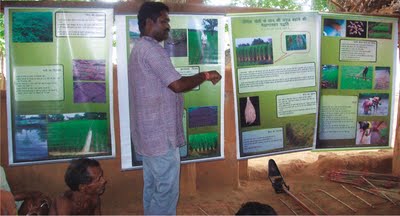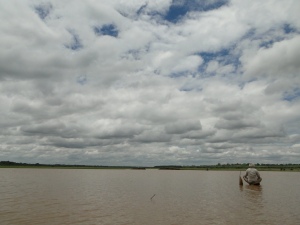/sub-categories/success-stories-and-case-studies
Success Stories and Case Studies
Introducing a new farming technique (SRI) in the Gangetic plains,Bihar
Posted on 28 Jul, 2011 03:19 PMArticle and Image courtesy: BodhiCommons
Farmers groups conserve traditional rice varieties in Bastar region of Chhattisgarh
Posted on 28 Jul, 2011 03:17 PM Chhattisgarh is traditionally known as the Rice Bowl of India. Over 20,000 rice varieties have been recorded in the region. These are a result of centuries of rice farming by indigenous communities through selection and adaptation to a variety of soil, water and micro-ecosystems conditions including predators.
Chhattisgarh is traditionally known as the Rice Bowl of India. Over 20,000 rice varieties have been recorded in the region. These are a result of centuries of rice farming by indigenous communities through selection and adaptation to a variety of soil, water and micro-ecosystems conditions including predators.
Today these varieties are being lost with market forces promoting so called high-yielding varieties and synthetic fertilizer and pesticide-based agriculture that focuses only on yield, as well as the general but incorrect perception of traditional varieties as low yielding. There has also been tremendous loss of traditional knowledge associated with traditional agro-ecosystems and production practices.
A natural system and an agricultural philosophy - A small-holder farmer in Punjab turns his land from a lifeless, debt ridden farm into a healthy, productive and profitable one - A film by The Source Project
Posted on 13 Jul, 2011 12:24 PMArticle and Video courtesy: The Source Project
The water wheels of time: Micro hydro power in the Western Ghats of India
Posted on 28 Jun, 2011 09:50 AMA citizen initiative to save Puttenahalli Lake in JP Nagar, Bangalore
Posted on 22 Jun, 2011 11:50 AMResidents of L&T South City and Brigade Millenium in JP Nagar, Bangalore formed a citizen initiative to save the neighbouring Puttenahalli Lake from becoming a dumping ground for construction debris and waste. A team from India Water Portal visited the lake in June 2011 to see the progress and challenges faced by such citizen initiatives.
Where our rivers begin - Water literacy for urban India
Posted on 20 Jun, 2011 12:37 PM
 Fisherman on Hessarghatta Lake on the Arkavathy River
Fisherman on Hessarghatta Lake on the Arkavathy River
It is here in a small pond that the Arkavathy river is famously said to originate. It moves down the hill in the form of a spring and enters the first of the man-made reservoirs, called ‘tanks’, the Chikkarayyappanhalli Kere. From thence begins the journey of this tributary to the Cauvery. Passing through a series of tanks built to hold its water for irrigation it comes to the large ‘Nagarakere’ at Dodballapur. The entire drinking water for the town of population 100,000 used to come from this large tank. Moving further on the river comes to the almost 7 sq.km. Large Hessarghatta tank. In 1894 this tank was enlarged and became the first external source of water supply to the city of Bangalore.
Presentations from the two-day workshop on success stories under watershed programmes by DoLR at New Delhi (2011)
Posted on 18 Jun, 2011 06:50 PMThe workshop was structured in two sections. Research papers were presented from research institutes such as Central Research Institute for Dryland Agriculture (CRIDA), Central Soil & Water Conservation Research and Training Institute (CSWRTI), Deutsche Gesellschaft für Internationale Zusammenarbeit (GIZ) GmbH, International Crops Research Institute for the Semi-Arid Tropics (ICRISAT), National Research Centre for Agroforestry (NRCAF), National Institute for Rural Development (NIRD) and National Bank for Agriculture and Rural Development (NABARD). This was followed by presentation of success stories by various States.
"Battles over land" - Land as commodity and land for livelihoods - Special issue from Infochange
Posted on 18 Jun, 2011 12:48 AMWhat are the laws governing acquisition? What is the social impact of a development-at-all-costs policy? Can those who owned and lived off the land have a stake in its development?
Villages in north Bihar sinking in Bagmati's sand - Entire flood control planning needs thorough review - Article by Dinesh Kumar Mishra in d-sector.org
Posted on 16 Jun, 2011 03:56 PM The Bagmati Embankment separating riverside on the left and countryside of the right near Ibrahimpur – Electric poles suggest the height of the embankment
The Bagmati Embankment separating riverside on the left and countryside of the right near Ibrahimpur – Electric poles suggest the height of the embankment
One often hears about the civilizations buried under earth and attributes various reasons for such disappearance of life from a particular place. Excavations reveal the way of life the people might have had before they chose to leave their villages and towns and allowed the nature to take its own course. These accounts are available in books and we all believe the process told to us by historians and archaeologists. These are all conjectures that are revealed by scientific investigations but how many of us have seen, not read, how the civilizations get buried under the debris created by nature? There are places in Bihar where one can see the process of disappearance of civilization and the villages getting buried under the sediments brought by rivers.
Patkhori's water solutions - A case study from the work of SM Sehgal Foundation in Mewat, Haryana
Posted on 14 Jun, 2011 05:27 PM Community water tank
Community water tank